The New York Times
April 12, 2005
India and China Agree to Resolve Decades of Border Disputes - Somini Sengupta
New York Times article continues after 5 paragraphs.
(What does this mean for the earth's deepest canyon the Yarlung Tsangpo Tibet? Blog added by Richard D. Fisher April 24, 2005)
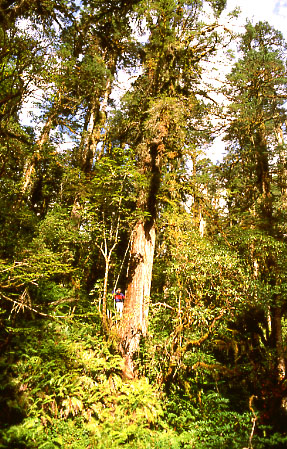
Asia's Largest Trees Critically Endangered
by China-India Free Trade Zone?
This virgin tropical rainforest consists of many
giant species, some of which are related to the
American Sequoia and Redwoods.
(Richard D. Fisher reports - Since October 1992, when I first entered the world's deepest canyon in eastern Tibet, I realized that the earth's largest and last pristine hardwood rainforest was protected by the incredibly steep terrain and vertical mountain walls of the Yarlung Tsangpo Gorge. I became quickly aware that this canyon protected what are most likely Asia's last great trees. This forest also protects a dozen species of critically endangered wildlife and perhaps the last of a little known Tibetan/Burmese pygmy tribe. I have photographed and documented this gorge in over ten major expeditions since 1992. This canyon is approximately three times as deep and five times as long as the Grand Canyon of the USA. As such, the Yarlung Tsangpo Gorge has at least six major sections, each one having a unique and very defined personality of its own.
Most of the other expeditions to the region have focused on just one area and that is what is referred to as the Rainbow Traverse or the Upper Inner Gorge of the Great Bend. While this is an extremely rugged area of the canyon, it does not contain the great trees, the possible pygmy tribe, most of the wildlife or history for that matter.
In 1998-2000, a western kayaker was killed in the Upper Inner Gorge and unfortunately another group sponsored what they called a "native hunt." This group allowed itself to be filmed gorging themselves on critically endangered wildlife. When the film was aired internationally the Chinese and Tibetan governments took great offense at such activities.
In 1998, the gorge was officially designated a national park. These groups represented that they were going to cover the national park aspect of this incredible gorge. The international airing of this film caused a major international incident as officials across Tibet and China were outraged by this killing of protected wildlife, the unsafe situation caused by the kayakers and the incredible and false claims made by this unique group of western "explorers". All of eastern Tibet was closed to western travel for a two-year time period after this incident. I, however, was able to continue my research and maintain the proper permits and permissions for entering this region to this day. From my rather extensive experience both Chinees and Tibetan authorities are very concerned about safety and the proper respect for the Nation Park designition.
For more than a decade I have been waiting "for the other shoe to drop" concerning the southern Tibetan forest which abutts the disputed zone. I knew that when India and China solved their border dispute at the south end of the gorge that the great trees could be cut and floated down river to an international market ravenous for such a rich resource. The middle and lower gorge are the focus of the great trees and forest and have protected and hidden this incredibly rich native, tribal, and wildlife habitat from the outside world. It is interesting to note that the natives that live in the section described in this email newsletter also report and firmly believe that the Himalayan Yetti also inhabits this closed section. If there is a Yetti this is where it could exist undetected by the out side world. Several major species thought to be extinct have been discovered in nearby areas in the last few years.
For more than a decade I have been waiting "for the other shoe to drop" concerning the southern Tibetan forest which abutts the disputed zone. I knew that when India and China solved their border dispute at the south end of the gorge that the great trees could be cut and floated down river to an international market ravenous for such a rich resource. The middle and lower gorge are the focus of the great trees and forest and have protected and hidden this incredibly rich native, tribal, and wildlife habitat from the outside world. It is interesting to note that the natives that live in the section described in this email newsletter also report and firmly believe that the Himalayan Yetti also inhabits this closed section. If there is a Yetti this is where it could exist undetected by the out side world. Several major species thought to be extinct have been discovered in nearby areas in the last few years.
I was very fortunate to cross this entire canyon segment in May 1993 and have visited it several times at later dates. For more general information on the Tsangpo Gorge, please visit www.canyonsworldwide.org Tibet chapter)
(The Yarlung Tsangpo Gorge, the World's Deepest Canyon,
National Park or Resource Exploitation Zone?)
National Park or Resource Exploitation Zone?)
From the New York Times
New Delhi: China and India agreed Monday to resolve a decades-old border dispute and let trade flourish between the countries.
Promising a new era of ''peace and prosperity'' between the world's two most populous countries, the announcement came during a four-day visit to India by Prime Minister Wen Jiabao of China.
It signaled an end to a protracted dispute over several patches along the 2,200-mile border between the countries, stretching from Kashmir to Myanmar. China defeated India in a war over territory in 1962, and relations have been fraught for four decades.
The two countries have reached ''a certain level of maturity,'' India's foreign secretary, Shyam Saran, said at a news conference here. ''India and China are partners, and they are not rivals,'' he added. ''We do not look upon each other as adversaries.''
The announcement did not spell out which territory would go to which country, but the two countries did agree to come up with a plan to resolve disputes over frontier territory. Each side has troops along the border, but there have not been any recent skirmishes.
Despite the border dispute, relations between India and China -- both nuclear powers, both witnessing rapid economic growth, both facing an enormous demand for energy -- have flourished in recent years, led primarily by trade. China is now India's second-largest trading partner, after the United States.
On Monday Mr. Wen and his Indian counterpart, Prime Minister Manmohan Singh, said the two countries expected to increase bilateral trade from $13 billion last year to at least $20 billion in 2008.
Chinese-made toys, toasters and televisions have proliferated across the Indian marketplace. India exports raw materials for China's booming construction industry.
''Aware of their linked destinies as neighbors and the two largest countries of Asia, both sides agreed that they would, together, contribute to the establishment of an atmosphere of mutual understanding, trust and cooperation in Asia and the world at large,'' read a joint statement.
India reiterated in the statement that it believed Tibet to be a part of Chinese territory; Tibetans, led by the Dalai Lama, have clamored for independence for decades. China in turn has recognized Sikkim, a tiny Himalayan finger poking into Tibet, as Indian territory. Annexed by India 30 years ago, Sikkim had been represented as an independent country until recently.
To drive the point home, Mr. Saran produced an official Chinese map showing Sikkim as part of India, ''the same color wash as the rest of India.''
India declared that it had China's backing for a permanent seat on the United Nations Security Council -- arguably India's principal foreign policy objective this year -- but the joint statement was less than explicit.
''China attaches great importance to the status of India in international affairs,'' the statement read. ''It understands and supports India's aspirations to play an active role in the U.N. and international affairs.''
Beyond the delicately worded statement and a brief appearance by Mr. Wen, the Chinese delegation did not make itself available to journalists, making it impossible to clarify its position on India's effort to gain a permanent seat or anything else.
Twelve separate agreements were signed during the visit, ranging from the border issues, to cooperation on filmmaking, to the export of Indian bitter gourds and grapes to China.
India and China also agreed to expand flights between the countries, and to military exchanges to enhance ''mutual trust'' between their armed forces. They also agreed to engage in joint exploration for oil and gas in other countries.
What India did not mention were agreements that China has made with India's neighbors and rivals, from building road links with Bangladesh to financing a deep-sea port in Pakistan. Senior Chinese officials also visited the king of Nepal, even after he ousted his government and declared emergency rule on Feb.1, a move India strongly condemned. (end New York Times story here - Kindly submitted for this newsletter by B. Davidson-Shaddox.)
(The following are photographs from the middle and lower Tsangpo Gorges during 1993-1995.
When I traversed this area on a number of occasions, I saw a relatively large number of very small people, both male and female, of different ages. I thought that extremely poor nutrition and/or inbreeding, which is very common in great canyons, was the reason for these very diminutive tribal people. It has just come to my attention through the Explorer's Club that these people may be descendents of Tibetan/Burmese pigmies that are known to have migrated and hidden themselves along the Tibetan and Burmese border. It may be possible that such a tribe actually exists. In addition to the photos here, I saw one group of very small, virtually naked people in a cave during a flood event. The weather conditions were so violent during those days and the situation was so strange and unique, I could not stop to take a photo. It is known that people from the Tibetan/Burmese border moved into the canyon in about 1850. Is it possible that some of the pygmy tribe also experienced conditions that forced them to move further from Chinese encroachment? It is known that some of these pygmy people moved into northern Burma and that three pure blood individuals remain to this day. I think there is a very great likelihood that perhaps several hundred of these tribal Tibetan pigmies exist in the gorge today. I am quite sure that these pigmies have intermarried with local tribal Loba and Tibetan peoples. Some of the adult men and all of the adult women were less than four feet tall.
The name of the Myanmar pygmy people is Tarone, but that is a name they "took on" when they left their homeland in China. They originated in the Tarone Valley of China and had another name there. I'll check my references at home (we're away at the moment) and send you what info I have on their history. Could be some went on to Tibet. Kindly submitted for this newsletter by B. Davidson-Shaddox.
Known wildlife species, short list, Tibet's last tigers, snow leopard, clouded leopard, Takin, three species of monkey, four species antelope and mountain sheep/goats, Asian black bear, several hundred species of birds and the local people strongly believe the Himalayan Yetti.)
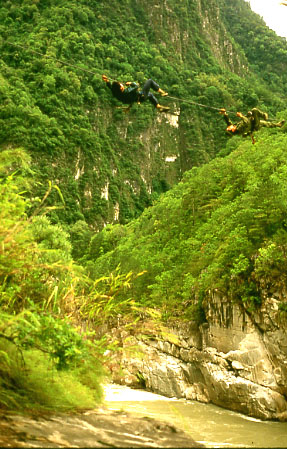
Entering the Middle and Lower Tsangpo Gorge
May 1993
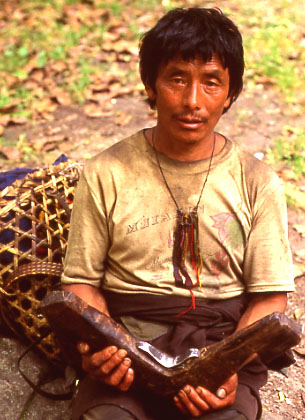
Possible Mixed Blood or Perhaps even Pure Blood
"Loba" Pygmy Man Displaying the Tribal Cable
Crossing Device which is More Primitive than the
Apparatus Used by Tibetans and Richard D. Fisher
During the Cable Crossing May 1993.

Possible Pygmy Hunter
Approximately 4 Feet, 5 Inches Tall
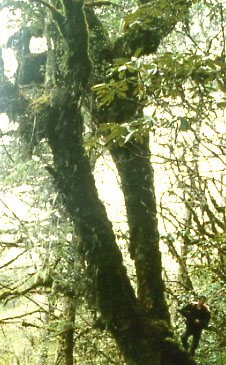
Same Hunter by Giant Oak Tree

This Very Small Hunter Guided
Me for Approximately One Week
Through the Middle Gorge
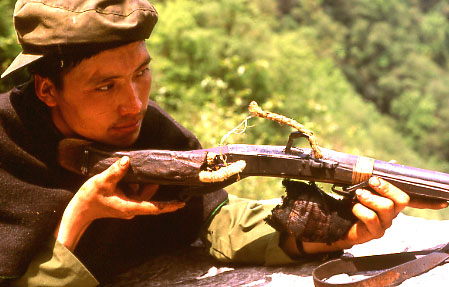
Close up of Possible Pygmy Hunter with Homemade Matchlock Rifle.
Wild Bill McGinley provides that this firearm requires a very steady aim and was
of a colonial era Chinese design. It is quite hazardous to the eyes of the shootist.
Thank you Wild Bill for this update!
Wild Bill McGinley provides that this firearm requires a very steady aim and was
of a colonial era Chinese design. It is quite hazardous to the eyes of the shootist.
Thank you Wild Bill for this update!
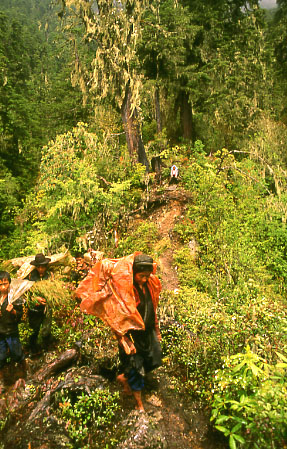
Possible Pygmy Family Traversing Middle Gorge
Barefooted. This is the same area where I saw
the extremely small people in the cave during a
flood event May 1993.
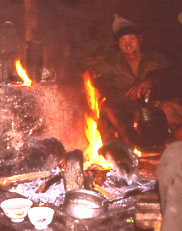
Villager Older Man
About 4 Feet Tall
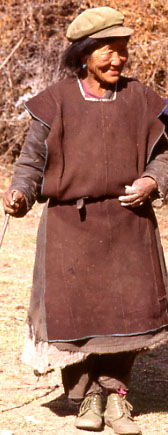
Possible Mixed Blood
Pygmy/Tibetan Woman
Approximately 4 Feet Tall
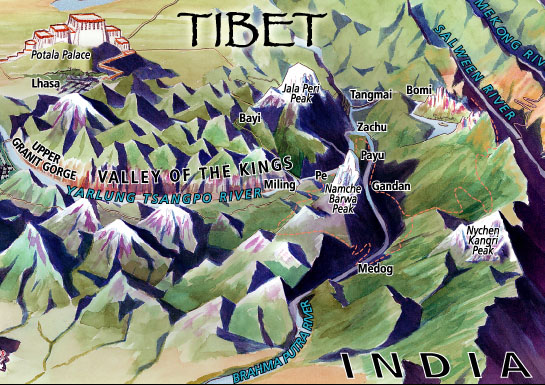
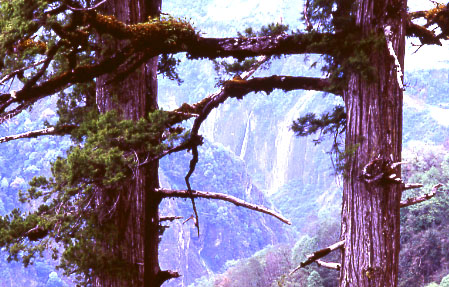
Endangered Giant Trees of the Tsangpo Gorge
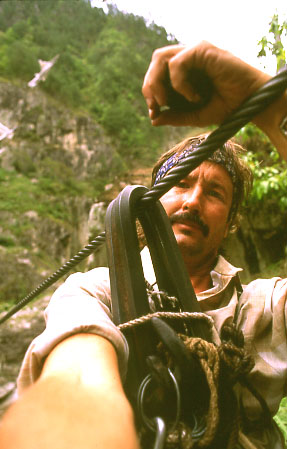
Cable Crossing into the Middle and
Lower Tsangpo
Lower Tsangpo
Gorges
Richard D. Fisher, Geographer, Author, Photographer
Canyons Worldwide

Richard D. Fisher Crossing 19,000 Foot Pass Exiting the Gorge After a Grueling
3-Week Survival Solo Trek. Fisher is modeling his patented "jungle mud patina"
clothing line. Only known westerner to have entered this region
clothing line. Only known westerner to have entered this region
or canyon section.
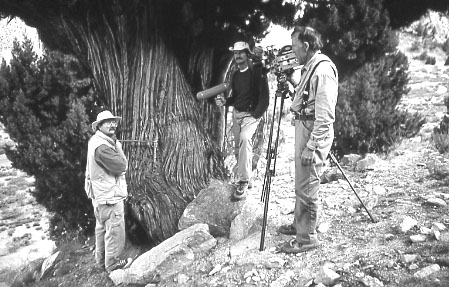
"UofA Scientists Thrilled with Tibet Research", Tucson Citizen, November 29, 1993
Scientific studies and dating of some of Tibet's oldest trees. Expedition sponsored
and led by Richard D. Fisher
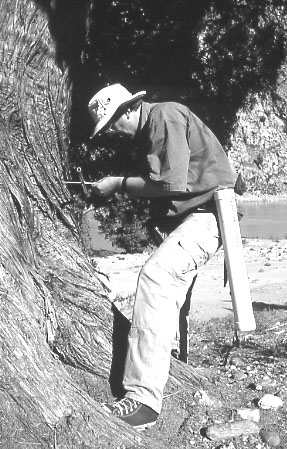
Dendrochronologist Taking Tree Rings Samples
Yarlung Tsangpo Gorge October 1993
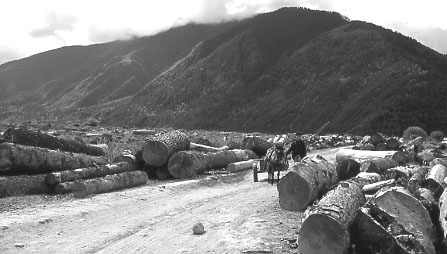
Wasted Forest from the Tibetan (Northern) Side of the Yarlung Tsangpo Gorge.
It is the rainforest on the southern side of the Himalayan Mountains in the
middle and lower gorges that are endangered by the current Chinese-Indian
resolution of border dispute and establishment of free trade practices in pristine
tropical hardwood forests.

Since 1986 I have explored all of the great
canyons of the central Asian/Tibetan plateau.
These trees are from the destruction of the
Jade Lord Gardens along the upper Yangtze
in 1988. These were perhaps China's last great
Sequoia trees moved to market and replaced
by a massive peasant agricultural development.
I have lots of photos of this area and deforestation
as well.
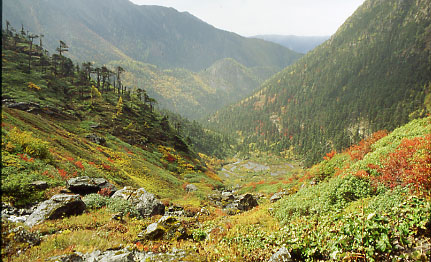
Last pass before the India/China disputed zone.
(I have many photographs and maps available from the Tsangpo Gorge and the canyonlands of central Asia. In 2004, I finished a documenting process of all of the Grand Canyons of the planet earth on six continents. You can view all of these canyonlands on www.canyonsworldwide.org Each of the major canyonlands has a very different story. Geology (Grand Canyon USA), anthropology (Copper Canyon Mexico), archaeology (Chaco Canyon), river running, canyoneering, origins of life (Canyonlands of Australia), history (Canyonlands of Ethiopia) in different canyon regions globally.
I have always thought that the story of the Tsangpo Gorge was the giant trees, forest, and the tribal cultures/endangered wildlife. Since 1992, I have sought to promote and organize scientific expeditions to the region to document what is perhaps the largest virgin rainforest left on the planet earth. With China and India resolving their border dispute, the resources can be floated down canyon in the various major rivers along the southern edge of the Tibetan plateau.
I have been able to maintain a cordial relationship with the Chinese and Tibetan authorities as well as the tribal groups that I had contact with. As far as I know, I am still the only American that has the proper legal permits and appropriate permissions to enter this area. It has been designated a national park and as such, the Chinese/Tibetan governments want the area covered as a protected zone.
I believe this is the perfect opportunity to reenter the middle and lower canyons to document the forest, possible pygmy tribes, and wildlife populations before deforestation perhaps takes place. The road traverse of the region is a first-class relatively comfortable trip by Tibetan standards via Toyota Landcruiser. Some sections of the road are even paved. Entering the middle and lower gorges, however, is a class 8 or 9 expedition and would be considered challenging and perhaps even dangerous in the extreme.
For further information, please contact Richard D. Fisher at sunracer@cox.net or (520)882-5341. Please feel free to pass this newsletter along to other interested parties. I would also appreciate any feedback or further information from our newsletter readers. Thank you so very much, friends!
Richard D. Fisher
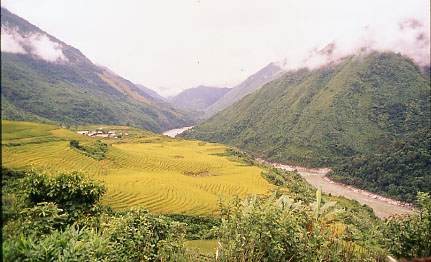
Last Tibetan village before India/China disputed zone. The last hill you see
in the background is where the disputed zone begins. You can easily see
that Great Trees can be skidded down these steep slopes and into the river
for export from China to India. The river provides a perfect conveyor belt for
these huge and extremely valuable trunks.
in the background is where the disputed zone begins. You can easily see
that Great Trees can be skidded down these steep slopes and into the river
for export from China to India. The river provides a perfect conveyor belt for
these huge and extremely valuable trunks.